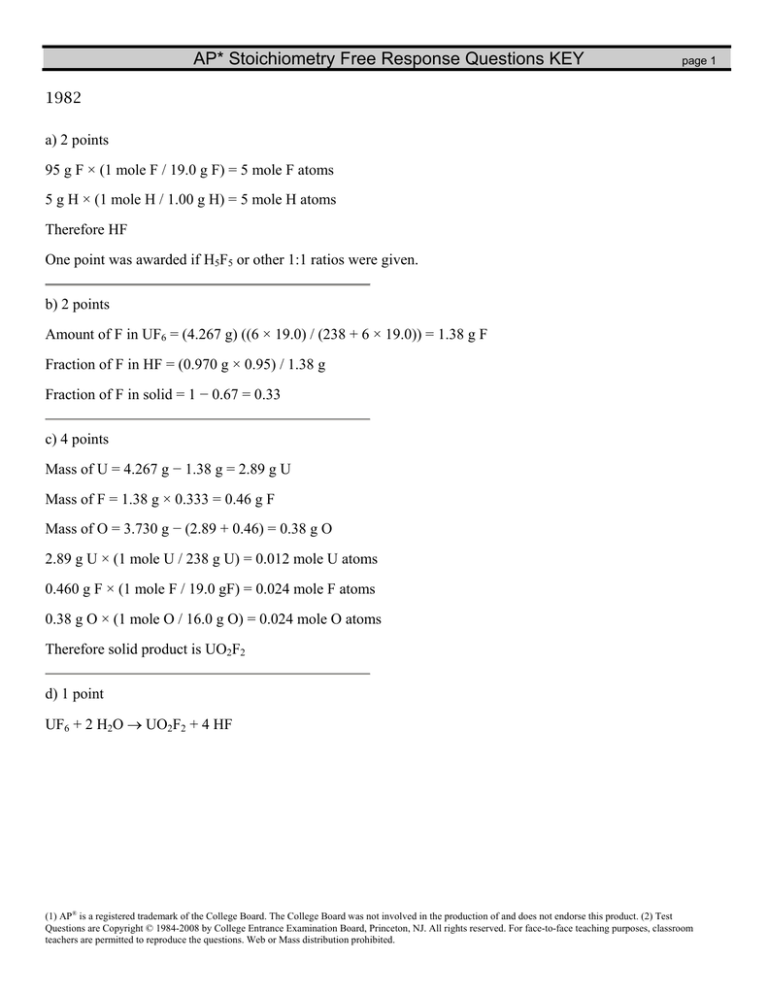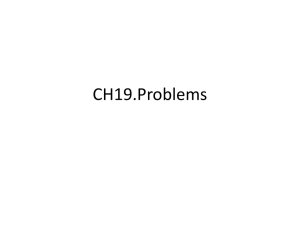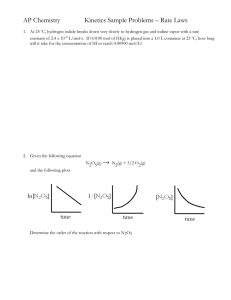
AP* Stoichiometry Free Response Questions KEY
page 1
1982
a) 2 points
95 g F × (1 mole F / 19.0 g F) = 5 mole F atoms
5 g H × (1 mole H / 1.00 g H) = 5 mole H atoms
Therefore HF
One point was awarded if H5F5 or other 1:1 ratios were given.
b) 2 points
Amount of F in UF6 = (4.267 g) ((6 × 19.0) / (238 + 6 × 19.0)) = 1.38 g F
Fraction of F in HF = (0.970 g × 0.95) / 1.38 g
Fraction of F in solid = 1 − 0.67 = 0.33
c) 4 points
Mass of U = 4.267 g − 1.38 g = 2.89 g U
Mass of F = 1.38 g × 0.333 = 0.46 g F
Mass of O = 3.730 g − (2.89 + 0.46) = 0.38 g O
2.89 g U × (1 mole U / 238 g U) = 0.012 mole U atoms
0.460 g F × (1 mole F / 19.0 gF) = 0.024 mole F atoms
0.38 g O × (1 mole O / 16.0 g O) = 0.024 mole O atoms
Therefore solid product is UO2F2
d) 1 point
UF6 + 2 H2O → UO2F2 + 4 HF
(1) AP® is a registered trademark of the College Board. The College Board was not involved in the production of and does not endorse this product. (2) Test
Questions are Copyright © 1984-2008 by College Entrance Examination Board, Princeton, NJ. All rights reserved. For face-to-face teaching purposes, classroom
teachers are permitted to reproduce the questions. Web or Mass distribution prohibited.
AP* Stoichiometry Free Response Questions KEY
1986
3) Average score = 5.18
a) three points
PV= (grams / MM) RT
MM = (3.53 grams / liter) (0.0821 liter atm/mole K) × (300 K) (1/[750/760]) = 88.1 grams/mole
OR
(3.53 grams / liter) (760/750) (300/273) × (22.4 L/mol) = 88.1 g/mol
b) one correct = 1 point; all correct = one additional point
gram Q/mole X = 0.648 × 88.1 = 57.1
gram Q/mole Y = 0.730 × 104 = 75.9
gram Q/mole Z = 0.593 × 64.0 = 38.0
c) one point
Masses in (b) must be integral multiples of atomic weight. Largest common denominator is 19.
Note: credit given for incorrect at. wt. if consistent with values in (b).
d) three points
1.37 grams CO2 (1 mole/44.0 grams CO2) = 0.0311 mole CO2 = 0.0311 mole C
0.281 grams H2O (1 mole/18.0 grams H2O) = 0.0156 mole H2O = 0.0312 mole H
1.00 gram Z = (1 mole/64 grams) = 0.0156 mole Z
Each mole Z contains 2 moles of CH, or 25 grams, which leaves (64 - 26) = 38 grams, corresponding to 2
moles of Element Q.
Mol. formula is C2H2Q2
page 2
AP* Stoichiometry Free Response Questions KEY
1991
2)
a) three points
7.2 g H2O ÷ 18.0 g/mol = 0.40 mol H2O
0.40 mol H2O × (2 mol H / 1 mol H2O) = 0.80 mol H
7.2 L CO2 ÷ 22.4 L/mol = 0.32 mol CO2
0.32 mol CO2 × (1 mol C / 1 mol CO2) = 0.32 mol C
OR
n = PV ÷ RT = [(1 atm) (7.2 L)] ÷ [(0.0821 L atm mol¯1 K1) (273 K)] = 0.32 mol CO2
0.80 mol H ÷ 0.32 = 2.5
0.32 mol C ÷ 0.32 = 1
2.5 × 2 = 5 mol H
1 × 2 = 2 mol C
empirical formula = C2H5
b) two points
mol O2 for combustion = mol CO2 + 1/2 mol H2O = 0.32 + 0.20 = 0.52 mol O2
0.52 mol O2 × 32 g/mol = 17 g O2
alternate approach for mol O2 from balanced equation
C2H5 + 13/4 O2 → 2 CO2 + 5/2 H2O
other ratio examples:
1, 6.5 → 4, 5
0.25, 1.625 → 1, 1.25
mol O2 = 0.40 mol H2O × (13/4 mol O2 / (5/2) mol H2O) = 0.52 mol O2
Note: starting moles of C2H5 = 0.16 mol C2H5
c) three points
MM stands for molar mass.
ΔT = (Kf (g/MM)) / kg of solvent
0.5 °:C = ((4.68 °:C kg mol¯:1) × (0.60 g / MM)) / 0.1 kg
page 3
AP* Stoichiometry Free Response Questions KEY
page 4
1
MM = (4.68 × 0.60) / (0.5 × 0.1) = 56 or 6 × 10
an alternate solution for (c)
molality = 0.5 °:C / (4.68 0.5 °:C/m) = 0.107 m
mol solute =( 0.107 mol / kg solvent) × 0.100 kg solvent = 0.0107 mol
MM = 0.60 g / 0.0107 mol = 56 or 6 × 101
d) one point
(56 g/mol of cmpd) / (29 g/mol of empirical formula) = 1.9 empirical formula per mol
OR
6 × 101 / 29 = 2.1
Empirical formula times 2 equals molecular formula = C4H10
1993 LAB: Redox Titration
3) average = three points
a) one point
(1.00 mol O2) (2 mol MnO2 / 1 mol O2) (1 mol I2 / 1 mol MnO2) (2 mol S2O32¯ / 1 mol I2) = 4 mol S2O32¯
Note: answer only is sufficient.
b) two points
mol S2O32¯ = (0.00486) (0.0112) = 5.44 × 10¯5 mol S2O32¯
mol O2 = 5.44 × 10¯5 / 4 = 1.36 × 10¯5 mol
c) one point
less I2 therefore less S2O32¯ required therefore lower amount of O2 (both direction and reason required)
d) three points (one for M; one for correct use of R; one for correct T)
Msoln in (b) = 1.36 ×10¯5 mol / 0.050 L = 2.72 × 10¯4 M
V = (nRT) / P = [(2.72 × 10¯4) (0.0821) (298)] / 1
= 6.65 × 10¯3 L or 6.65 mL
AP* Stoichiometry Free Response Questions KEY
e) two points
starch indicator
color disappears or blue disappears (violet or purple OK)
color change alone is not sufficient for 2nd pt
any other color with starch is not sufficient for 2nd pt
page 5
AP® Chemistry 2000 ─ Scoring Standards
Question 3
(10 points)
(a)
Molar Mass = [9.012 + 2(12.011) + 4(16.00) + 3(16.00 + 2(1.0079))] g mol−1
= (97.034 + 54.0474) g
% Carbon =
mol−1
= 151.0814 g
1 pt.
mol−1
2 (12.011)
× 100 = 15.90%
151.0814
1 pt.
• No point earned for 0.1590.
(b)
(i)
3.21 g BeC2O 4 ⋅ 3 H 2O
151.0814 g mol−1
= 0.02124 mol BeC2O 4 ⋅ 3 H 2O
0.02124 mol BeC2O4 ⋅ 3 H2O ×
1 mol BeC2O 4
= 0.02124 mol BeC2O 4
1 mol BeC2O 4 ⋅ 3 H 2O
0.02124 mol BeC2O4 × 97.034 g mol−1 = 2.06 g BeC2O4
or
97.034 g mol−1
% BeC2O4 =
× 100% = 64.23%
151.0814 g mol−1
1 pt.
Mass BeC2O4 = 3.21g × 0.6423 = 2.06 g
• No point earned for an answer larger than original mass (3.21g)
(ii) 0.02124 mol BeC2O4⋅3 H2O ×
V=
3 mol H 2O
= 0.0637 mol H2O
1 mol BeC2O 4 ⋅ 3 H 2O
nRT (0.063mol) (0.0821Latm mol−1 K −1 ) ((220 + 273) K)
=
= 2.67 L H 2O
P
(735 / 760) atm
or
2 pts.
3.21 g BeC2O4⋅3 H2O − 2.06 g BeC2O4 = 1.15 g H2O
1.15 g H 2O
18.02 g mol−1H 2O
= 0.0639 mol H 2O Þ use ideal gas law as above
Note: One point is earned for determining the amount of H2O(g) formed and one point
is earned for the proper use of the ideal gas law with a consistent answer.
Copyright © 2000 College Entrance Examination Board and Educational Testing Service. All rights reserved.
AP is a registered trademark of the College Entrance Examination Board.
AP® Chemistry 2000 ─ Scoring Standards
Question 3
(continued)
(c)
(i) The reducing agent is C2O42−
1 pt.
• Also accepted: C2O4=, BeC2O4 , C2O4 , or 5 C2O42−
(ii)
nMnO
nC
2
O4
−
4
= (0.0150 mol L−1 ) × (0.01780 L) = 2.67 × 10 −4 mol MnO 4 −
1 pt.
5
5
nMnO − = (2.67 × 10 − 4 ) = 6.68 × 10 − 4 mol C 2O 4 2 −
4
2
2
1 pt.
2−
=
Notes: One point is earned for determining nMnO − and one point is earned for
4
determining nC O
2
2−
4
. An incorrect value of nMnO
internally consistent, value for nC O
2
2−
4
−
can lead to an incorrect, but
4
. A point may be earned if nMnO
−
is
4
correctly calculated (i.e., reflects correct stoichiometry of the balanced equation)
from an incorrect value of nC O
2
(iii) Total nC
2O 4
2−
=
2−
.
4
100. mL
× nMnO − = 5 (6.68 × 10− 4 mol C 2O 42 − )
4
20.0 mL
1 pt.
= 3.34 × 10−3 mol C2O42−
(iv) mol BeC2O4 = mol C2O42− = 3.34 × 10−3 mol C2O42−
mass BeC2O4 = (3.34 × 10−3 mol BeC2O4)(97.034 g mol−1) = 0.32385 g
0.32385 g BeC2O 4
% BeC2O4 =
× 100% = 93.9%
0.345 g sample
1 pt.
Note: The point is earned if an incorrect value for moles of BeC2O4 is used correctly
in the calculation.
Copyright © 2000 College Entrance Examination Board and Educational Testing Service. All rights reserved.
AP is a registered trademark of the College Entrance Examination Board.
AP® CHEMISTRY
2003 SCORING GUIDELINES (Form B)
Question 2
Total Score 10 points
2. Answer the following questions that relate to chemical reactions.
(a) Iron(III) oxide can be reduced with carbon monoxide according to the following equation.
Fe2O3(s) + 3 CO(g) → 2 Fe(s) + 3 CO2(g)
A 16.2 L sample of CO(g) at 1.50 atm and 200.°C is combined with 15.39 g of Fe2O3(s).
(i) How many moles of CO(g) are available for the reaction?
PV = nRT
PV
nCO =
RT =
(1.50 atm) (16.2 L)
= 0.626 mol CO
L·atm
0.0821 mol·K (473 K)
1 point for correct substitution
1 point for answer
(ii) What is the limiting reactant for the reaction? Justify your answer with calculations.
nFe
2O3
æ 1 mol Fe2O3 ö
= 15.39 g Fe2O3 ç159.7 g Fe O ÷ = 0.0964 mol Fe2O3
nCO required
è
2 3ø
3 mol CO ö
= 0.0964 mol Fe2O3 æç
÷ = 0.289 mol
1
è mol Fe2O3ø
CO required to completely react with 0.0964 mol Fe2O3
0.626 mol CO are available, so CO is in excess and Fe2O3 is
limiting.
OR
nFe
2O3 required
æ1 mol Fe2O3 ö
= 0.626 mol CO ç 3 mol CO ÷ = 0.209 mol
è
ø
0.209 mol Fe2O3 corresponds to 33.4 g Fe2O3 (the amount of
Fe2O3 required to completely react with 0.626 mol CO)
1 point for moles of CO or
Fe2O3 required
1 point for correct conclusion
NOTE: Answer must be
consistent with moles of CO
calculated in part (a)
0.0964 mol of Fe2O3 is available, so there is not enough Fe2O3
to completely react with 0.626 mol CO. Therefore, Fe2O3 is the
limiting reactant.
Copyright © 2003 by College Entrance Examination Board. All rights reserved.
Available at apcentral.collegeboard.com.
5
AP® CHEMISTRY
2003 SCORING GUIDELINES (Form B)
Question 2 (cont’d.)
(iii) How many moles of Fe(s) are formed in the reaction?
2 mol Fe ö
nFe = 0.0964 mol Fe2O3 æç
÷ = 0.193 mol Fe produced
è1 mol Fe2O3ø
If 0.626 mol CO is used as the limiting reactant, then the number of
moles of Fe formed is:
2 mol Fe ö
nFe = 0.626 mol CO æ
= 0.417 mol Fe
è3 mol COø
1 point for correct number
of moles of Fe formed
Note: Values
must be consistent with
answer in part (a) (ii).
(b) In a reaction vessel, 0.600 mol of Ba(NO3)2(s) and 0.300 mol of H3PO4(aq) are combined with
deionized water to a final volume of 2.00 L. The reaction represented below occurs.
3 Ba(NO3)2(aq) + 2 H3PO4(aq) → Ba3(PO4)2(s) + 6 HNO3(aq)
(i) Calculate the mass of Ba3(PO4)2(s) formed.
æ 2 mol H3PO4 ö
nH3PO4 = 0.600 mol Ba(NO3)2ç
3 mol Ba(NO ) ÷ = 0.400mol H3PO4
è
3 2ø
required to completely react with 0.600 mol Ba(NO3)2 . There is
0.300 mol H3PO4 available. Therefore, H3PO4 is the limiting reactant.
1 point for determining
the limiting reactant
æ1 mol Ba3(PO4)2ö
÷×
è 2 mol H3PO4 ø
massBa3(PO4)2 = 0.300 mol H3PO4ç
æ602 g Ba3(PO4)2 ö
ç1 mol Ba (PO ) ÷ = 90.3 g Ba3(PO4)2
3
4 2ø
è
If Ba(NO3)2 is used as the limiting reactant:
æ1 mol Ba3(PO4)2ö
massBa3(PO4)2 = 0.600 mol Ba(NO3)2 ç
÷
è 3 mol Ba(NO3)2 ø
æ602 g Ba3(PO4)2 ö
ç1 mol Ba (PO ) ÷ = 120. g Ba3(PO4)2
3
4 2ø
è
1 point for determining
the correct mass of
Ba3(PO4)2
Copyright © 2003 by College Entrance Examination Board. All rights reserved.
Available at apcentral.collegeboard.com.
6
AP® CHEMISTRY
2003 SCORING GUIDELINES (Form B)
Question 2 (cont’d.)
(ii) Calculate the pH of the resulting solution.
æ 6 mol HNO3 ö
nHNO = 0.300 mol H3PO4 ç
÷ = 0.900 mol HNO3
3
è2 mol H3PO4ø
0.900 mol HNO3
= 0.45 M
[HNO3] =
2.0 L
Since all the H3PO4 has reacted, the only acid in the solution is
HNO3. Since HNO3 is a strong acid it completely dissociates.
pH = −log[H+] = −log(0.45) = 0.35
If Ba(NO3)2 is used as the limiting reactant
æ 6 mol HNO3 ö
nHNO = 0.600 mol Ba(NO3)2 ç
÷ = 1.2 mol HNO3
3
è3 mol Ba(NO3)2ø
1.2 mol HNO3
= 0.60 M
[HNO3] =
2.0 L
pH = −log[H+] = −log(0.60) = 0.22
1 point for number of
moles of H+
1 point for calculation of
[H+] and pH
Must be consistent with
part (b) (i)
(iii) What is the concentration, in mol L−1, of the nitrate ion, NO3−(aq), after the reaction reaches
completion?
The final concentration of NO3− must be the same as the initial
concentration.
æ 2 mol NO3− ö
÷ = 1.2 mol NO3−
nNO − = 0.600 mol Ba(NO3)2 ç
3
è1 mol Ba(NO3)2ø
[NO3−] =
−
1.2 mol NO3
= 0.60 M NO3−
2.0 L
1 point for concentration
of NO3−
Copyright © 2003 by College Entrance Examination Board. All rights reserved.
Available at apcentral.collegeboard.com.
7
AP® CHEMISTRY
2003 SCORING COMMENTARY (Form B)
Question 2
Sample 2A (Score 10)
This response earned a perfect score. A summary of the earned points for the response is as follows: 2 points for
part (a)(i), part (a)(ii), part (b)(i) and part (b)(ii), and 1 point each for part (a)(iii) and part (b)(iii) .
Sample 2B (Score 8)
In part (a)(ii) of this good response, the limiting reactant is correctly identified but not sufficiently justified, thus
only one point was earned. In part (b)(iii), the fact that 0.600 mol of Ba(NO3)2 is the sole source of nitrate ion is
overlooked, leading to an incorrect result that earned no point.
Sample 2C (Score 7)
In this response, only one point was earned in part (b)(i) because an incorrect formula mass for Ba3(PO4)2 is used.
In part (b)(ii), a point is earned for the correct numbers of moles of NO3 − formed, but the calculation of pH is
unfinished, so the second point was not earned. A common error is shown in part (b)(iii); no point was earned
because dissolved HNO3 is responsible for only part of the NO3 − in the solution.
Copyright © 2003 by College Entrance Examination Board. All rights reserved.
Available at apcentral.collegeboard.com.
3






